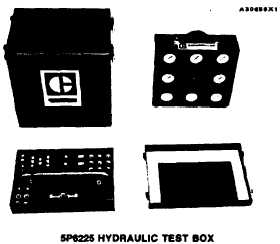LUBRICATION SYSTEM
TM 5-3805-263-14&P-2
TESTING AND ADJUSTING
LUBRICATION SYSTEM
One of the problems in the following list will
generally be an indication of a problem in the
lubrication system for the engine.
TOO MUCH OIL CONSUMPTION
OIL PRESSURE IS LOW
OIL PRESSURE IS HIGH
TOO MUCH BEARING WEAR
TOO MUCH OIL CONSUMPTION
Oil Leakage on Outside of Engine
Check for leakage at the seals at each end of the
crankshaft. Look for leakage at the oil pan gasket
and all lubrication system connections. Check to see
if oil is coming out of the crankcase breather. This
can be caused by combustion gas leakage around the
pistons. A dirty crankcase breather will cause high
pressure in the crankcase, and this will cause gasket
and seal leakage.
Oil Leakage Into Combustion
Area of Cylinders
Oil leakage into the combustion area of the cy-
linders can be the cause of blue smoke. There are
four possible ways for oil leakage into the combus-
tion area of the cylinders:
1. Oil leakage between worn valve guides and valve
stems.
2. Worn or damaged piston rings or dirty oil return
holes.
3. Compression ring not installed correctly.
4. Oil leakage past the seal rings in the impeller end
of the turbocharger shaft.
Too much oil consumption can also be the result of
using oil with the wrong viscosity. Oil with a thin
viscosity can be caused by fuel getting in the crank-
case, or by the engine getting too hot.
OIL PRESSURE IS LOW
An oil pressure gauge that has a defect can give an
indication of low oil pressure. Check the gauge with a
test gauge.
Use the procedure that follows to check engine oil
pressure. Do the procedure exactly or the pressure
measurements are not good for comparison with the
chart.
1. Be sure that the engine is filled to the correct
level with either SAE 10 or SAE 30 oil. If any
other viscosity of oil is used, the information in
the engine oil pressure chart is not good.
1-62
2.
3.
Find a location on the engine oil manifold to
install a tee. The easiest method is to remove the
sending unit for the present gauge and install a
tee at this location. Install a probe from the
9S9102 Thermistor Thermometer Group in one
side of the tee. Connect an 8M2744 Gauge from
the 5P6225 Hydraulic Test Box to the other side
of the tee.
Run the engine to get the engine oil temperature
at 210°F (99°C).
NOTE: A 5° F (3°C) increase in temperature gives
approximately 1 psi (7 kPa) decrease in engine oil
pressure.
4. Keep the engine oil temperature constant. With
the engine at the rpm from the chart, read the
pressure gauge. Make a comparison between the
pressure reading on the test gauge and the mini-
mum permissible pressure from the ENGINE
OIL PRESSURE CHART. If the pressure
reading on the test gauge is below the minimum
permissible pressure, find the cause and correct



